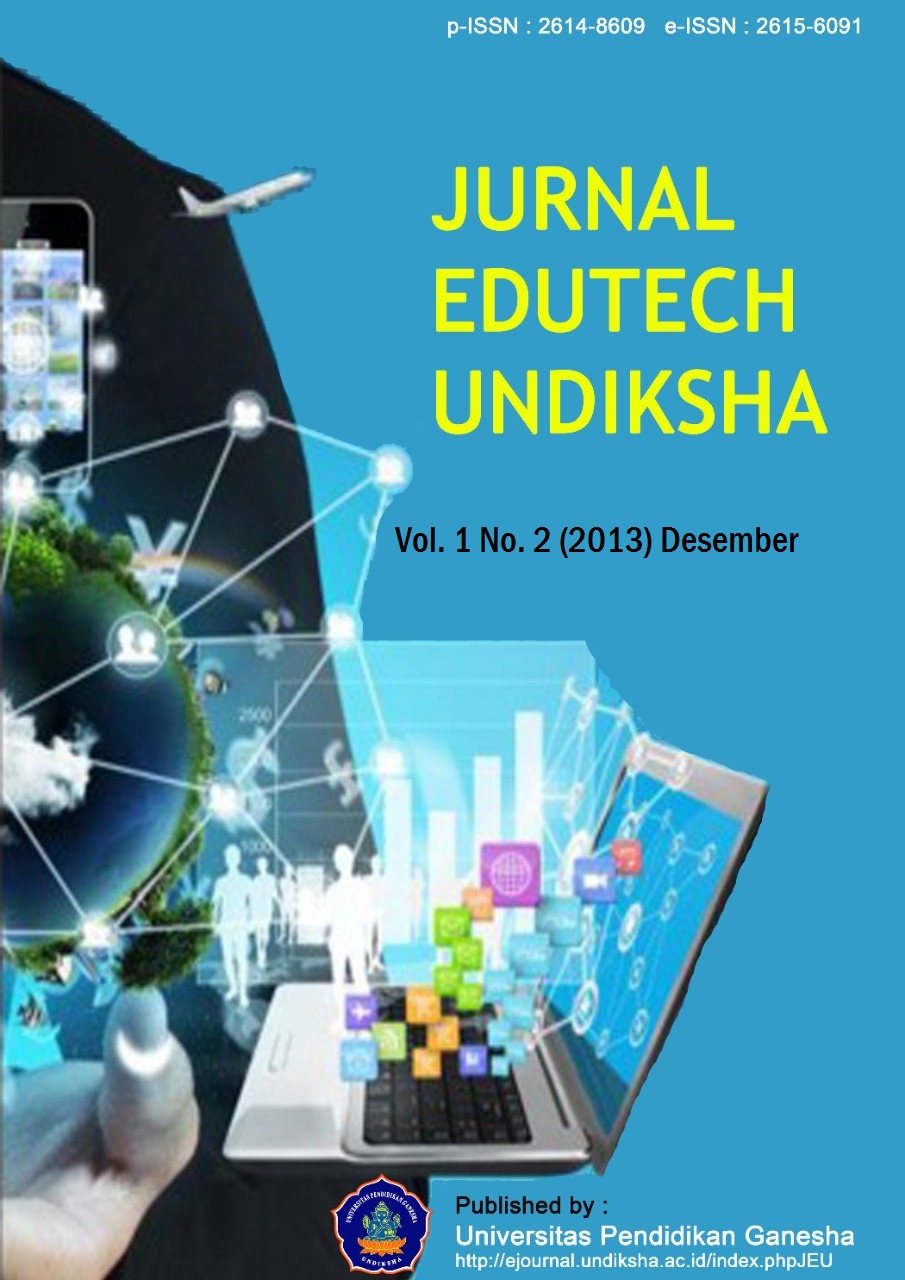PENGEMBANGAN MEDIA PEMBELAJARAN BERBASIS AUTHOWARE PELAJARAN IPA SISWA SMP NEGERI 3 SAWAN KELAS VIII SEMESTER GENAP
DOI:
https://doi.org/10.23887/jeu.v2i1.4090Abstract
Penelitian ini bertujuan (1) mendeskripsikan rancang bangun multimedia; (2) mengetahui hasil validitas multimedia pembelajaran IPA untuk siswa kelas VIII SMP; dan (3) mengetahui efektivitas penggunaan media authoware pembelajaran terhadap hasil belajar IPA siswa kelas VIII SMP. Penelitian pengembangan ini menggunakan model dari Mardika (2008) sebagai tahapan pengembangan. Data yang dikumpulkan dalam penelitian ini adalah data validasi ahli isi mata pelajaran, ahli media dan ahli desain pembelajaran serta data dari hasil belajar IPA untuk melihat efektivitas media. Instrumen pengumpulan data yang digunakan dan tes untuk hasil belajar IPA berupa kuesioner untuk ahli isi mata pelajaran, ahli media pembelajaran, ahli desain pembelajaran, uji coba perseorangan, dan uji coba kelompok kecil. Analisis data menggunakan tiga teknik yaitu teknik analisis deskriptif kualitatif, teknik analisis deskriptif kuantitatif, dan teknik analisis statistik inferensial. Rancang bangun multimedia yaitu membuatkan storyboard. Hasil validitas dari evaluasi ahli isi sebesar 92,86% pada kualifikasi sangat baik. Ahli desain sebesar 87,69% pada kualifikasi baik. Ahli media sebesar 93,04% pada kualifikasi sangat baik. Hasil uji perorangan sebesar 90% pada kualifikasi sangat baik. Mengetahui efektivitas pengguna media yaitu Hasil uji kelompok kecil sebesar 90% pada kualifikasi sangat baik. Hasil uji lapangan sebesar 86,29% pada kualifikasi baik. Penghitungan hasil belajar secara manual diperoleh hasil t hitung sebesar 11,70. Harga t tabel taraf signifikansi 5% adalah 2,00. Jadi harga t hitung lebih besar daripada harga t tabel sehingga H0 ditolak dan H1 diterima. Hasil belajar IPA siswa setelah menggunakan media (81,67) lebih tinggi dibandingkan sebelum menggunakan media (63).Kata Kunci : pengembangan, multimedia, IPA
This study aims to (1) describe the design of multimedia; (2) determine the validity of the results of multimedia learning science for eighth grade students of SMP; and (3) determine the effectiveness of the use of media authoware learning on learning outcomes Junior High School eighth grade science students. This study uses a model Mardika (2008) as a development stage. The data collected in this study is a data validation expert subject matter content, media experts and design experts as well as data from student learning. Data collection instrument was a questionnaire for course content experts, instructional media specialists, instructional design expert, individual testing, and testing of small groups. Analysis of the data using three techniques namely qualitative descriptive analysis, descriptive analysis of narrative, descriptive and quantitative analysis techniques. The results of the expert evaluation of the content of 92.86% on the excellent qualifications. Expert design by 87.69% on good qualification. Media expert at 93.04% in very good qualification. Individual test results by 90% in very good qualification. Small group of test results by 90% in very good qualification. The results of the field test was 86.29% at good qualifications. Calculation results obtained manually learning outcomes t count of 11.70. Price t table significance level of 5% is 2.00. So the price of t is greater than the price of the t table so that H0 is rejected and H1 is accepted. IPA student learning outcomes after using the media (81.67) was higher than before using the media (63).
keyword : development, multimedia, IPA
Published
2014-10-22
How to Cite
., K. J. S., ., D. I. N. J., & ., P. D. A. A. G. A. (2014). PENGEMBANGAN MEDIA PEMBELAJARAN BERBASIS AUTHOWARE PELAJARAN IPA SISWA SMP NEGERI 3 SAWAN KELAS VIII SEMESTER GENAP. Jurnal Edutech Undiksha, 2(1). https://doi.org/10.23887/jeu.v2i1.4090
Issue
Section
Articles
License
Authors who publish with the Jurnal EDUTECH Undiksha agree to the following terms:
- Authors retain copyright and grant the journal the right of first publication with the work simultaneously licensed under a Creative Commons Attribution License (CC BY-SA 4.0) that allows others to share the work with an acknowledgment of the work's authorship and initial publication in this journal.
- Authors are able to enter into separate, additional contractual arrangements for the non-exclusive distribution of the journal's published version of the work (e.g., post it to an institutional repository or publish it in a book), with an acknowledgment of its initial publication in this journal.
- Authors are permitted and encouraged to post their work online (e.g., in institutional repositories or on their website) prior to and during the submission process, as it can lead to productive exchanges, as well as earlier and greater citation of published work. (See The Effect of Open Access)














